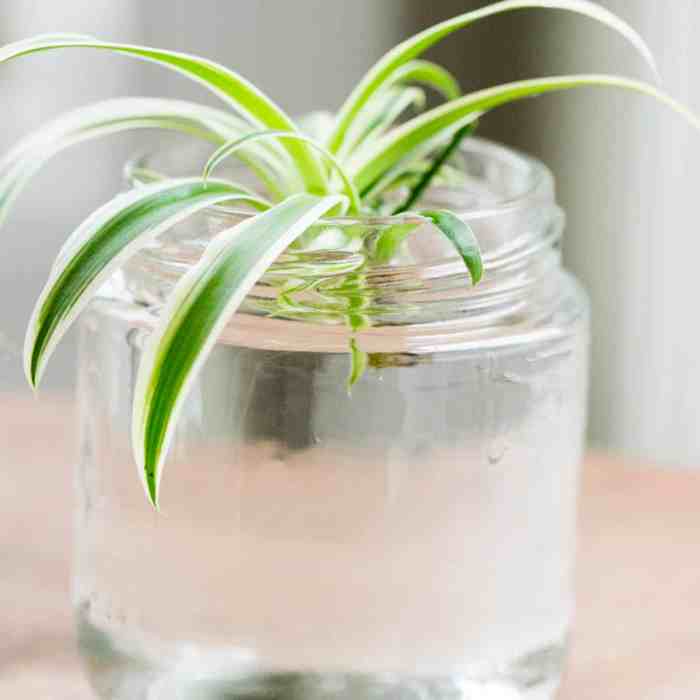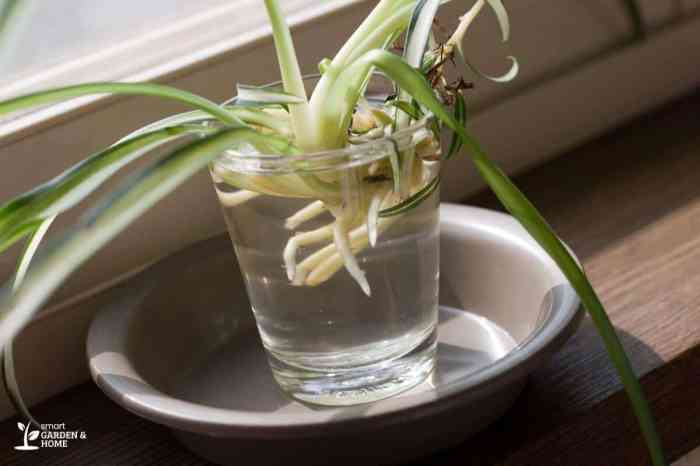How Often to Water a Spider Plant
Understanding Spider Plant Watering Needs
How often to water a spider plant – Proper watering is crucial for the health and vitality of your spider plant. Several factors influence how often you need to water, ensuring your plant thrives.
Factors Affecting Watering Frequency

Source: greengardencottage.com
The frequency of watering your spider plant depends on a combination of factors. Understanding these will help you establish a suitable watering routine.
- Pot Size: Smaller pots dry out faster than larger ones, requiring more frequent watering.
- Soil Type: Well-draining potting mixes dry out quicker than those that retain more moisture. A peat-based mix, for instance, may need less frequent watering than a soil-heavy mix.
- Season: During warmer months (spring and summer), plants transpire more rapidly, demanding more frequent watering. In cooler months (autumn and winter), watering frequency should be reduced.
- Humidity: Higher humidity levels slow down the rate of water evaporation from the soil, thus reducing the need for frequent watering.
- Light: Plants in bright, sunny locations tend to dry out faster than those in shadier spots.
Signs of Underwatering and Overwatering
Recognizing the signs of underwatering and overwatering is vital for maintaining a healthy spider plant.
Underwatering:
- Dry, brittle soil.
- Wilting leaves that don’t recover after watering.
- Leaf tips turning brown and crispy.
- Slow growth or stunted growth.
Overwatering:
- Soggy, waterlogged soil.
- Yellowing leaves that may droop.
- Root rot (roots become mushy and brown).
- Foul-smelling odor from the soil.
Watering Needs in Different Environments
| Environment | Watering Frequency (Summer) | Watering Frequency (Winter) | Notes |
|---|---|---|---|
| Indoor, Bright Light | Every 7-10 days | Every 14-21 days | Monitor soil moisture closely. |
| Indoor, Low Light | Every 10-14 days | Every 2-3 weeks | Water less frequently due to slower evaporation. |
| Outdoor, Sunny | Every 5-7 days | Every 10-14 days | Increased evaporation necessitates more frequent watering in summer. |
| Outdoor, Shady | Every 7-10 days | Every 14-21 days | Similar to indoor bright light conditions. |
Developing a Watering Schedule
A consistent watering schedule, adjusted for seasonal changes, ensures your spider plant receives the right amount of water.
Sample Watering Schedule
This is a general guideline; adjust based on your specific environment and plant needs.
- Spring: Water every 7-10 days.
- Summer: Water every 5-7 days (or more frequently in hot, dry conditions).
- Autumn: Water every 10-14 days.
- Winter: Water every 14-21 days or even less frequently, depending on the temperature and humidity.
Checking Soil Moisture
Before watering, always check the soil moisture level to prevent overwatering. Several methods exist:
- Finger Test: Insert your finger about an inch into the soil. If it feels dry, it’s time to water. If it’s still moist, wait a few days.
- Moisture Meter: A soil moisture meter provides a precise reading of the soil’s moisture content.
- Weight Test: Lift the pot. A lighter pot indicates dry soil.
Adjusting Watering Based on Environmental Changes
Adjust watering frequency based on environmental shifts.
- Increased Heat: Water more frequently during heatwaves to compensate for increased evaporation.
- Air Conditioning: Lower humidity from air conditioning may require slightly less frequent watering.
Watering Techniques
Different watering methods can impact your spider plant’s health. Choose a method that suits your plant and lifestyle.
Watering Methods
Top watering and bottom watering are common methods, each with advantages and disadvantages.
- Top Watering: Pour water directly onto the soil surface until it drains from the drainage holes. This is the most common method and is generally effective.
- Bottom Watering: Place the pot in a tray of water and allow the plant to absorb water from the bottom. This method helps to ensure even moisture distribution but can lead to overwatering if not monitored carefully.
Tips for Proper Watering
- Avoid letting the soil completely dry out between waterings.
- Water thoroughly until water drains from the drainage holes.
- Empty any excess water that collects in the saucer or tray to prevent root rot.
- Avoid wetting the leaves excessively, as this can promote fungal diseases.
Watering a Hanging Basket
Watering a spider plant in a hanging basket requires a slightly different approach. Submerge the entire pot in a container of water for about 15-20 minutes, allowing the soil to absorb water thoroughly. Allow excess water to drain completely before returning the basket to its hanging position.
Proper watering is key for a thriving spider plant; generally, you should water when the top inch of soil feels dry. However, the plant’s ability to retain moisture also depends on its overall health, and this relates to nutrient uptake. Learning whether does calcium for plants help them retain water can be beneficial in understanding how to optimize your spider plant’s hydration.
Ultimately, consistent monitoring of soil moisture is the best approach to ensure your spider plant receives the right amount of water.
Troubleshooting Watering Issues: How Often To Water A Spider Plant
Addressing watering problems promptly is crucial for your spider plant’s survival.
Common Watering Problems and Solutions
| Problem | Cause | Solution | Prevention |
|---|---|---|---|
| Yellowing Leaves | Overwatering or underwatering | Adjust watering frequency; check for root rot. | Monitor soil moisture regularly. |
| Wilting Leaves | Underwatering or root rot | Water thoroughly; check for root rot and repot if necessary. | Ensure proper drainage. |
| Root Rot | Overwatering | Repot in fresh, well-draining soil; remove affected roots. | Avoid overwatering; ensure good drainage. |
| Brown Leaf Tips | Underwatering or mineral buildup | Water thoroughly; flush soil with water to remove mineral salts. | Use filtered water; avoid using tap water with high mineral content. |
Reviving an Underwatered or Overwatered Spider Plant
Reviving a spider plant depends on whether it’s underwatered or overwatered.
Underwatered: Gradually rehydrate the plant by watering thoroughly. Avoid overwatering. Monitor closely for recovery.
Overwatered: Remove the plant from the pot, gently remove excess soil, and check for root rot. Repot in fresh, well-draining soil, ensuring good drainage.
Long-Term Care and Maintenance
Consistent, appropriate watering is essential for the long-term health of your spider plant.
Maintaining Optimal Watering Conditions, How often to water a spider plant

Source: smartgardenhome.com
- Use a well-draining potting mix.
- Select a pot with drainage holes.
- Monitor soil moisture regularly.
- Adjust watering frequency according to seasonal changes and environmental conditions.
- Consider using a moisture meter for accurate readings.
Ideal Watering Scenario
Imagine a spider plant in a 6-inch terracotta pot, situated on a bright windowsill, not in direct sunlight. The soil is checked regularly using the finger test. Watering occurs every 7-10 days during summer, reducing to every 14-21 days in winter, always ensuring thorough drainage after watering to prevent waterlogging. The soil remains consistently moist but never soggy.
Question Bank
What type of water is best for spider plants?
Use room-temperature water; avoid using cold water directly from the tap.
Can I use tap water?
Tap water is generally acceptable, but letting it sit for 24 hours allows chlorine to dissipate, benefiting the plant.
My spider plant’s leaves are drooping. Is it underwatered or overwatered?
Drooping leaves can indicate both. Check the soil moisture; dry soil points to underwatering, while soggy soil suggests overwatering.
How do I know if my spider plant needs repotting?
If roots are circling the pot or growing out of the drainage holes, it’s time for a larger pot.




















